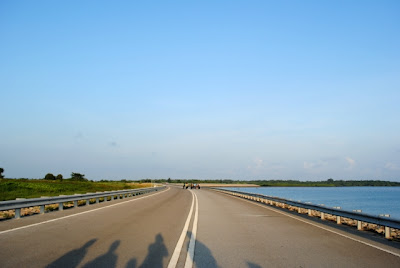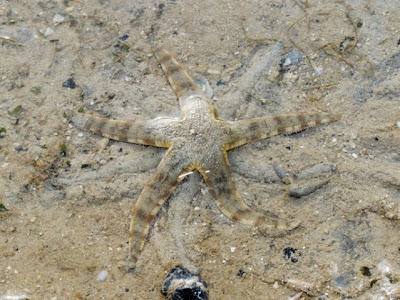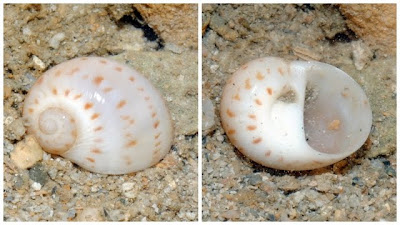My seven consecutive days of fruitful low tide field trips (and unfortunately also sleep deprivation) ended with two days of guiding at Semakau!
 On Monday, I guided an enthusiastic group of West cluster teachers and they were such a great bunch of audience despite the quote which says that teachers are the worst students. (All group photos can be downloaded in large sizes by clicking on them)
On Monday, I guided an enthusiastic group of West cluster teachers and they were such a great bunch of audience despite the quote which says that teachers are the worst students. (All group photos can be downloaded in large sizes by clicking on them)
 For a change, my Tuesday group consist of Biology students that I am currently teaching from my school. Joining us are two other Bio teachers. Here we are doing a traditional seagrass meadow group shot! Just like the seagrass of the Halophila genus, these people are saying a hearty "Halo!" to all of you!!
For a change, my Tuesday group consist of Biology students that I am currently teaching from my school. Joining us are two other Bio teachers. Here we are doing a traditional seagrass meadow group shot! Just like the seagrass of the Halophila genus, these people are saying a hearty "Halo!" to all of you!!
 As it was the morning tide, we had to walk 2 km or so to the intertidal area since the van and bus are not ready yet. It was a good morning exercise!
As it was the morning tide, we had to walk 2 km or so to the intertidal area since the van and bus are not ready yet. It was a good morning exercise!
 The sky was particularly clear and fair on the second day. It looks totally blue! That also suggests that the day will be really hot.
The sky was particularly clear and fair on the second day. It looks totally blue! That also suggests that the day will be really hot.
 We first stopped by the mangroves to look at the ecosystem, adaptations and the other organisms that live among them.
We first stopped by the mangroves to look at the ecosystem, adaptations and the other organisms that live among them.
 The hunter seekers found a tiny Pygmy squid (Idiosepius sp.). Like other squids, it can change colours rapidly to camouflage itself. The camouflaging is not too obvious in this case though.
The hunter seekers found a tiny Pygmy squid (Idiosepius sp.). Like other squids, it can change colours rapidly to camouflage itself. The camouflaging is not too obvious in this case though.
 Ron flipped the rocks near the mangrove roots and he stumbled upon this Crown sea star (Asterina coronata) which we also call as the Rock sea star. They are usually found among rocks and sometimes on seagrasses.
Ron flipped the rocks near the mangrove roots and he stumbled upon this Crown sea star (Asterina coronata) which we also call as the Rock sea star. They are usually found among rocks and sometimes on seagrasses.
 This pair of Common sea stars (Archaster typicus) are practising an unique mating ritual where they release sperms and eggs externally. Thus, this leads to external fertilisation.
This pair of Common sea stars (Archaster typicus) are practising an unique mating ritual where they release sperms and eggs externally. Thus, this leads to external fertilisation.
 Two of the common sea cucumbers are found and shown in this photo. The one at the top is the Dragonfish sea cucumber (Stichopus horrens) which the one at the bottom is the Stonefish sea cucumber (Actinopyga lecanora). Also found is the Garlic bread sea cucumber (Holothuria scabra). I have not seen the Ocellated sea cucumber (Stichopus ocellatus) for a long time already though.
Two of the common sea cucumbers are found and shown in this photo. The one at the top is the Dragonfish sea cucumber (Stichopus horrens) which the one at the bottom is the Stonefish sea cucumber (Actinopyga lecanora). Also found is the Garlic bread sea cucumber (Holothuria scabra). I have not seen the Ocellated sea cucumber (Stichopus ocellatus) for a long time already though.
 I love to show the art of flipping rocks to the participants as this shows them that many intertidal organisms hide beneath rocks where there is less stress such as heat or dessication than above rocks. Here are a pair of tiny brittle stars. Can you spot both?
I love to show the art of flipping rocks to the participants as this shows them that many intertidal organisms hide beneath rocks where there is less stress such as heat or dessication than above rocks. Here are a pair of tiny brittle stars. Can you spot both?
 Another tiny critter would be this unknown crab that was also found near rocks.
Another tiny critter would be this unknown crab that was also found near rocks.
 The hunter seekers found a pretty Upsidedown jellyfish (Cassiopea sp.) that prefers to be upside down because they harbour microalgae on their tentacles. Therefore, they need to be upside down to make food through photosynthesis. This photo shows the closeup shot on the tentacles facing upwards.
The hunter seekers found a pretty Upsidedown jellyfish (Cassiopea sp.) that prefers to be upside down because they harbour microalgae on their tentacles. Therefore, they need to be upside down to make food through photosynthesis. This photo shows the closeup shot on the tentacles facing upwards.
 Another interesting find by the hunter seekers would be this dead moon snail shell belonging to a uncommon species. Ria has seen the living version before at Cyrene Reef.
Another interesting find by the hunter seekers would be this dead moon snail shell belonging to a uncommon species. Ria has seen the living version before at Cyrene Reef.
 Like the Spider conch (Lambis lambis), this Noble volute (Cymbiola nobilis) is also a large and pretty snail. Too bad we did not see the former as our group for the second day was called Spider Conch.
Like the Spider conch (Lambis lambis), this Noble volute (Cymbiola nobilis) is also a large and pretty snail. Too bad we did not see the former as our group for the second day was called Spider Conch.
 One of the star attractions of the guided walk is definitely the Knobbly sea stars (Protoreaster nodosus).
One of the star attractions of the guided walk is definitely the Knobbly sea stars (Protoreaster nodosus).
 And thus also explains the perfect opportunity for another group photo near or at the coral reef where these sea stars are found.
And thus also explains the perfect opportunity for another group photo near or at the coral reef where these sea stars are found.
 Here is another group photo with the sea star on the second day with the students.
Here is another group photo with the sea star on the second day with the students.
 While walking on the coral reef area, I also personally stumbled upon yet another Knobbly sea star!
While walking on the coral reef area, I also personally stumbled upon yet another Knobbly sea star!
 Though we did not see this pretty Cushion star (Culcita novaeguinea) on the first day and almost also on the second day, a participant from Tammy's group spotted this sea star that is shaped like a ball. Well done! The shape probably explains why they are called Cushion stars!
Though we did not see this pretty Cushion star (Culcita novaeguinea) on the first day and almost also on the second day, a participant from Tammy's group spotted this sea star that is shaped like a ball. Well done! The shape probably explains why they are called Cushion stars!
 The tide was slightly lower on the first day and I could bring the teachers for a short walk at the coral reef area. Over here, we could find several colourful hard corals such as the Brain corals (Family Mussidae) and Lettuce corals (Pavona sp.).
The tide was slightly lower on the first day and I could bring the teachers for a short walk at the coral reef area. Over here, we could find several colourful hard corals such as the Brain corals (Family Mussidae) and Lettuce corals (Pavona sp.).
 It was a treat to also find the uncommon Cabbage coral (Trachyphyllia geoffroyi). This particular juvenile coral is in bright neon green!
It was a treat to also find the uncommon Cabbage coral (Trachyphyllia geoffroyi). This particular juvenile coral is in bright neon green!
 The Fluted giant clam (Tridacna squamosa) never fails to amaze many of the participants. It is always heartening to see this particular giant clam doing well and growing bigger through these years.
The Fluted giant clam (Tridacna squamosa) never fails to amaze many of the participants. It is always heartening to see this particular giant clam doing well and growing bigger through these years.
 I'll end the post with the ever cutish sluggy finds. This Polka-dot nudibranch (Jorunna funebris) was exactly the nudibranch found on the first day's group batch. We were called the Nudibranchs! Naked ones haha!
I'll end the post with the ever cutish sluggy finds. This Polka-dot nudibranch (Jorunna funebris) was exactly the nudibranch found on the first day's group batch. We were called the Nudibranchs! Naked ones haha!
 While the previous slug is white, this one is black with purple dots. This is the Black phyllid nudibranch (Phyllidiella nigra).
While the previous slug is white, this one is black with purple dots. This is the Black phyllid nudibranch (Phyllidiella nigra).
 Ending off, we have a Bohol nudibranch (Discodoris boholiensis) that seems to be quite commonly found recently. Perhaps they are in season.
Ending off, we have a Bohol nudibranch (Discodoris boholiensis) that seems to be quite commonly found recently. Perhaps they are in season.
Wow, indeed the 7 days consecutive low spring tide field trips was exhausting. But it was also really worthwhile as our shores as just so fantastic with lots of sightings waiting to be discovered.
Don't believe me? In today's Straits Times, there is an article that features our sea anemones and world anemone expert, Dr Daphne Fautin. We have more species of anemones here in Singapore than the entire west coast of North America! Dr Daphne Fautin is in Singapore to study our anemones and conduct a workshop. You may be interested to have a look at the screen shots of her public lecture on Tuesday.
More photos of the trips here:
1) June 20th's trip: http://www.flickr.com/photos/koksheng/archives/date-taken/2011/06/20/
2)June 21st's trip:http://www.flickr.com/photos/koksheng/archives/date-taken/2011/06/21/












 Another interesting find by the hunter seekers would be this dead moon snail shell belonging to a uncommon species. Ria has seen the living version before at Cyrene Reef.
Another interesting find by the hunter seekers would be this dead moon snail shell belonging to a uncommon species. Ria has seen the living version before at Cyrene Reef.





 The tide was slightly lower on the first day and I could bring the teachers for a short walk at the coral reef area. Over here, we could find several colourful hard corals such as the Brain corals (Family Mussidae) and Lettuce corals (Pavona sp.).
The tide was slightly lower on the first day and I could bring the teachers for a short walk at the coral reef area. Over here, we could find several colourful hard corals such as the Brain corals (Family Mussidae) and Lettuce corals (Pavona sp.).









No comments:
Post a Comment